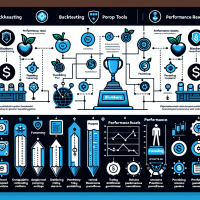Proven Prop Trading Market Analysis Strategies
Prop trading demands a refined approach, combining market analysis with advanced backtesting and robust strategy development. This comprehensive guide is tailored to traders, quants, risk managers, and decision makers seeking to excel in proprietary trading. We dive into cutting-edge tools, actionable insights, and common challenges to help you leverage backtesting for optimal trading results.

Figure 1: A dynamic interface showcasing a backtesting report essential for prop trading analysis.
Advanced Backtesting Techniques in Prop Trading
Effective backtesting is the cornerstone of a successful trading strategy in prop trading environments. However, many traders fall into common pitfalls such as overfitting, survivorship bias, and look-ahead bias. By addressing these issues through rigorous testing protocols, you can mitigate risk and increase confidence in your strategies.
Understanding Common Pitfalls
- Overfitting: Excessively tuning models to historical data which fails in real market conditions.
- Survivorship Bias: Analyzing only the successful assets and ignoring failures, skewing results.
- Look-ahead Bias: Using future data points in model training that wouldn’t have been available in real scenarios.
Pro Tip: Always use out-of-sample data to confirm the robustness of your model and incorporate walk-forward optimization techniques to adapt as market conditions change.
Integrating Python for Automated Backtesting
Using Backtrader in a Python environment is a common and effective approach to automate backtesting. Below is a sample code snippet to demonstrate how a basic strategy can be simulated:
import backtrader as bt
class TestStrategy(bt.Strategy):
def __init__(self):
self.sma = bt.indicators.SimpleMovingAverage(self.data.close, period=15)
def next(self):
if self.data.close[0] > self.sma[0]:
self.buy()
elif self.data.close[0] < self.sma[0]:
self.sell()
cerebro = bt.Cerebro()
data = bt.feeds.YahooFinanceData(dataname='AAPL', fromdate=datetime(2015,1,1), todate=datetime(2017,12,31))
cerebro.adddata(data)
cerebro.addstrategy(TestStrategy)
cerebro.run()
cerebro.plot()
Detailed Tool Comparisons for Backtesting
There are several industry-standard tools that automate backtesting for prop trading. Below is a comparative overview of three recognized platforms:
| Tool | Backtesting Features | Data Quality | Integration | Pricing & Use Case |
|---|---|---|---|---|
| TradingView | Vectorized strategies, integrated optimization, commission/slippage modeling | Robust historical data for diverse asset classes, real-time feeds | API access, broker integration, compatible with other analytics platforms | Free & premium tiers; great for both prop firms and advanced retail traders |
| NinjaTrader | Event-driven backtesting, stress testing, detailed scenario analysis | Extensive historical and tick data, customizable asset ranges | APIs for custom integration, broker connectivity | Cost-effective licensing; popular in proprietary and institutional environments |
| QuantConnect | Automated parameter optimization, walk-forward optimization, detailed reports | High-quality data across equities, forex, and crypto | Cloud-based API, seamless broker integrations | Free trial with scalable pricing; ideal for quants in prop trading firms |
These tools each offer distinct advantages. For example, TradingView is highly visual and user-friendly, whereas NinjaTrader provides detailed event-driven testing mechanisms. QuantConnect excels in advanced optimization features, making it ideal for firms focused on quantitative research.

Figure 2: Comparative chart of advanced backtesting tools utilized in prop trading environments.
Case Studies & Real-World Examples
Prop trading firms often face challenges such as rapidly changing market conditions and the need to adjust risk parameters quickly. Consider an anonymized case study where a mid-sized prop firm implemented QuantConnect’s automated parameter optimization. They tackled issues of delayed data feeds and inconsistent backtesting reports by integrating walk-forward testing. The result? A significant improvement in their strategy’s Sharpe ratio from 1.2 to 1.8 over six months, alongside a 15% reduction in maximum drawdown.
Integrating Backtesting with Forward Testing & Regulatory Compliance
The transition from backtesting to live trading must be seamless. Prop firms should employ forward testing methods such as paper trading to validate strategies in real-time conditions. Key performance metrics, including drawdown limits and profit factors, must be continuously monitored during this phase. Furthermore, adherence to regulatory frameworks like MiFID II, ESMA regulations, and NFA rules is critical. Compliance tools integrated into platforms like NinjaTrader can assist in tracking and reporting these metrics.
Best Practices for Effective Integration
- Conduct extensive out-of-sample testing before live deployment.
- Combine automated backtesting with forward testing (e.g., paper trading) to identify discrepancies.
- Utilize scenario analysis and stress testing to prepare for unforeseen market events.
- Regularly update data feeds and adjust for corporate actions to maintain accuracy.
Next Steps & Recommended Resources
To further solidify your prop trading strategy, consider downloading our comprehensive Risk Management Checklist that outlines key risk ratios, monitoring techniques, and contingency plans. Additionally, explore our internal resources on advanced prop trading strategies and risk management for prop traders for deeper insights.
By integrating advanced backtesting techniques, utilizing powerful automated tools, and maintaining a strict compliance regimen, you can significantly enhance your prop trading performance. Stay updated with industry developments and continuously refine your approach to outperform in competitive markets.
As of October 2023, the above strategies and tools reflect the latest trends and regulatory standards in prop trading. We encourage you to implement these practices and join our upcoming webinar on advanced backtesting strategies to gain further actionable insights.







